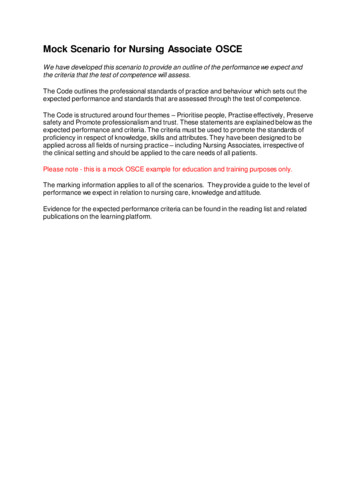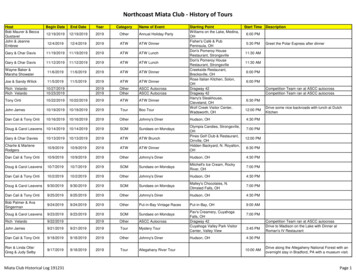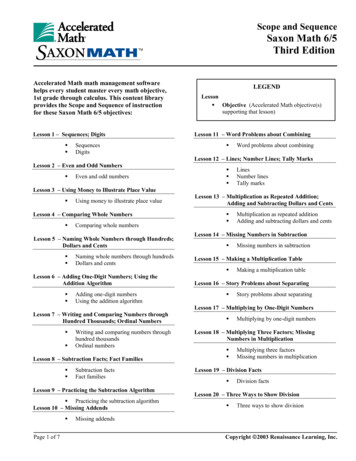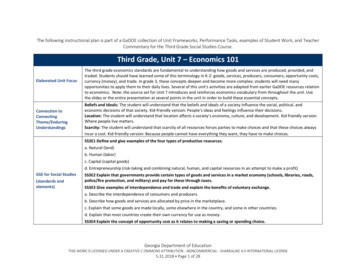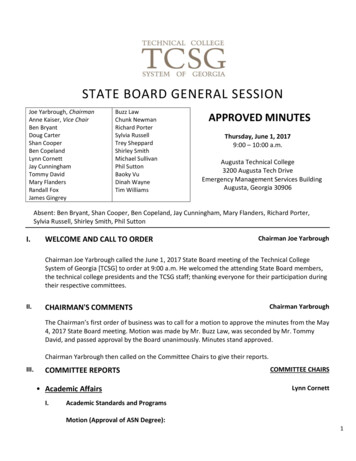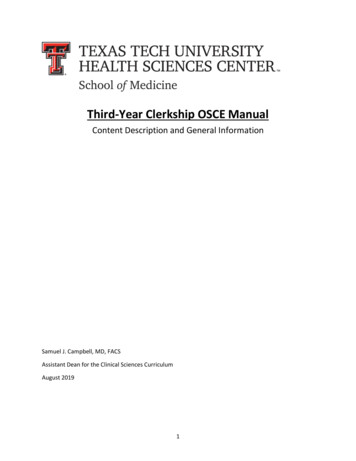
Transcription
Third-Year Clerkship OSCE ManualContent Description and General InformationSamuel J. Campbell, MD, FACSAssistant Dean for the Clinical Sciences CurriculumAugust 20191
Table of ContentsTopicPageIntroduction3OSCE Structure4Description of the Exam5-8Scoring8Rules of Conduct and Testing Regulations8AppendicesA: Common Presentations on USMLE Step 2CSB: Communication and Interpersonal Skills ChecklistC: Patient Note ScreenD: Common AbbreviationsE: Guidelines for writing a Patient Note in Step 2CS format2
IntroductionThe OSCE (Objective Standardized Clinical Encounter) Experience in your Third-Year Clerkships is designedto assess your ability via simulated patient encounters, to create a patient-centered encounter, addressthe diagnostic challenges posed, to prepare the patient for next steps, and lastly, to document theencounter appropriately. The USMLE has identified 72 common signs and symptoms thatform the basis for the Step 2CS Exam which is designed to “assess a physician’s ability to apply knowledge,concepts, and principles, and to demonstrate fundamental patient-centered skills that are important inhealth and disease management and that constitute the basis of safe and effective patient care.” Thesecommon presenting signs and symptoms are listed in Appendix A. Appendix B provide a screenshotdepicting the note format. A link to the USMLE Step 2CS practice note site will allow writing notes withcharacter and line limits and a ten-minute time limit.Your OSCE score will represent 15% of your Final Clerkship Grade.Note: The contents of this manual are based closely on the instructions provided by the NBME for studentspreparing to take USMLE Step 2CS. This relationship is intentional as a goal of both our Clerkship OSCEprogram and the Longitudinal Clinical Skills Examination (LCSE) is to assist learners as they prepare for theStep 2CS Examination.3
OSCE StructureIn a standardized patient encounter, you will determine the patient’s presenting symptom, perform afocused History and (usually) Physical examination, develop a working differential diagnosis, and create alist of the next steps in the patient’s work-up. The standardized patients (SP) will evaluate you using achecklist. The SP’s checklist is an evaluation of your communication and interpersonal skills (CIS), one ofthe grading components of Step 2CS. After the encounter, you will document your patient’s History,Physical Examination, Differential Diagnoses, and the next steps in your patient’s Work-up. Your writtennote will serve as a second component of the grading of an OSCE, which corresponds to the integratedclinical encounter (ICE) component of Step 2CS. Your OSCE occurs during week eight of your Third-YearClerkship except for Psychiatry, which occurs on Friday during week seven. You have a total of fifteen (15)minutes for the patient encounter. You have ten (10) minutes for the written note. If you finish the patientencounter before the fifteen-minute time limit, you may apply the additional time on your note. You willgo through a transition during each of the first three Clerkship OSCEs. You will have character and linelimits as follows for the History:Clerkship Period #Character LimitLine Limit11150 characters25 lines21050 characters20 lines3-6950 characters15 linesThe OSCE character and line limits for the Physical Exam will be:Clerkship Period #Character Limit11150 characters25 lines21050 characters20 lines950 characters15 lines3-6Line LimitThe rationale for character and line limits is to allow you to adjust to the character and line limits for theUSMLE Step 2CS Exam.You are required to successfully pass the STEP 2CS (Clinical Skills) Exam for graduation. The Step 2CS examhas three graded components, Spoken English-Proficiency (SEP), Communication and Interpersonal Skills(CIS), and the Integrated Clinical Encounter (ICE). You must pass each component to pass the exam. It isrequired that on-cycle students take USMLE Step 2CS prior to October 31 of their fourth year and, inpractice, most students take the exam between June and September. The character and line limits for Step2CS are:4
Character LimitLine Limit950 characters15 linesDuring the Spring semester of Year 3 (February for FMAT students; May for everyone else) the LongitudinalClinical Simulation Encounter (LCSE) will occur as practice for USMLE Step 2CS. The LCSE is a six-stationOSCE that is designed to simulate the twelve-station USMLE Step 2CS. The LCSE has identical characterand line limits as those used in Clerkship Period 3,4,5, and 6 OSCEs.Description of the ExaminationTimingYou should arrive at least 15 minutes early at the Simulation Center on your home campus. Your ClerkshipCoordinator will advise you as to the start time of the examination. The OSCE encounters are timed events,so do not arrive late for your exam. OSCEs occur at the same time on each campus for each clerkshipaccording to the schedule listed belowClerkshipTimeFamily MedicineWeek 8, Wed amInternal MedicineWeek 8, Wed pmObstetrics and GynecologyWeek 8, Tues pmPediatricsWeek 8, Mon amPsychiatryWeek 7, Friday amSurgeryWeek 8, Tues amLocationYour OSCE encounter will occur in the designated Testing Area. Your Clerkship Coordinator will instructyou regarding campus-specific information.Policies and ProceduresThe Clerkship OSCEs and LCSE are conducted under the SOM OP 30.01, Grading Policy, SOM OP 30.01,Appendix F, SOM OP 30.03, Electronic Devices, and SOM OP 30.09, Educational Record and GradeAppeal Policy. All OSCEs are graded on a 100-point scale (30% contributed by the Communication andInterpersonal Skills (CIS) component, 70% by the Integrated Clinical Encounter (ICE) component) and finalscores are converted to a 15-point scale. No electronic devices are allowed during the OSCE, including thePatient Encounter and Note Writing tasks of the OSCE. A score of 70% is required for passing the OSCE.SOM OP 30.01, provides guidelines for actions in MSIII Clerkships for the failure of an OSCE.5
ClothingWear comfortable, professional attire with a clean, white lab coat. Men should have a necktie, and womenshould have closed toe shoes. (taken from the Step 2 CS manual)EquipmentThe only required medical equipment is your stethoscope. The Sim Center provides all other necessarymedical equipment.Onsite Equipment and Examinee InstructionsThe Testing Area of the Sim Center will consist of a standardized exam room. An examination table, chair,BP cuffs, otoscopes and ophthalmoscopes, gloves, sinks, towels, and antibiotic foam dispensers are inthe standardized room. You may need to adjust the table for your patient’s comfort during theexamination. You are expected to use any drapes as necessary to protect your patient’s modesty.Outside the exam room, you are provided a clipboard with a blank paper for taking notes. You are expectedto bring your pen for taking notes during the encounter. A note detailing the patient's name, age, gender,and reason for visiting the doctor will be facing away from you at the doorway. It also indicates his or hervital signs, including heart rate, blood pressure, temperature (Celsius andFahrenheit), and respiratory rate, unless instructions indicate otherwise. You may not look at the note inadvance of the announcement that the patient encounter has begun. You can accept the vital signs on theexaminee instruction sheet as accurate, and do not need to repeat them unless you believe the casespecifically requires it. You may encounter a case in which the examinee instructions include the resultsof a lab test. In this type of patient encounter, the patient is returning for a follow-up appointment afterundergoing testing. The doorway instructions will indicate whether, in these instances, you must performa physical examination.The Patient EncounterYou will have 15 minutes for each SP encounter. Once the announcement “Students, you may begin” isgiven, you may look at the information sheet and begin your encounter. You must knock on the doorbefore entering. You should introduce yourself and begin your conversation after closing the exam door.You should treat each SP as you would an actual patient. The SP will be evaluating you based on the6
encounter using the Communication and Interpersonal Skills (CIS) Checklist. The CIS Checklist is found inAppendix C. Communicate in a professional and empathetic manner, being responsive to the patient’sneeds. You should respond appropriately to the patient's needs and ask the patient questions andcommunicate using nonmedical jargon. You will need to communicate the working diagnoses and nextsteps in the workup of the patient’s problem. You should determine the patient’s willingness to participatein the next steps and gauge their understanding of their present illness.Physical ExaminationYou should perform a directed physical examination based on your patient’s history and potentialdifferential diagnoses. You should wash your hand or use antimicrobial foam before examining the patient.It is important that you respect the patient’s comfort and modesty. You will need to move their drapes toavoid unnecessary exposure. It is an expectation that you listen with a stethoscope directly on the skinand not on the gown or through clothing. It is critical that you apply no more pressure than the amountof pressure that is appropriate when performing tasks such as the abdominal exam, examination forMurphy’s sign, Obturator or Psoas sign, eliciting CVA tenderness, and examination of the ears with anotoscope.You should interact with the standardized patients as you would with any patients you may see with similarproblems. Do not perform the following: rectal, pelvic, genitourinary, inguinal hernia, female breast, orcorneal reflex examinations. If indicated, you should include them in your proposed diagnostic work-up.Do not perform a throat swab for a throat culture; include it in your workup. All other examinationmaneuvers are completely acceptable, including femoral pulse exam, inguinal node exam, and axillaryexam.The overhead speaker will make announcements when to begin the patient encounter, when 5 minutesremain, and when the patient encounter is over.If you complete the patient encounter in fewer than 15 minutes, you may leave the examination roomearly to begin your note. Be certain that you have obtained all necessary information before leaving theexamination room. You are not permitted to re-enter the examination room. Re-entering an examinationroom after leaving will be considered misconduct.Telephone/Video Patient EncountersTelephone/video patient encounters may occur during the Pediatric OSCE, LCSE, and even Step 2 CS. Theseencounters begin like all encounters with a case-specific doorway instruction sheet. Once theannouncement "Students, you may now begin,” you make notes about the case before entering the examroom. Upon entering the room, sit at the desk in the front of the room. You should conduct the encountervia phone or via video link and take a history and ask pertinent questions. Because no physical exam ispossible, leave that section of the note blank.Immediately after each patient encounter, you will have 10 minutes to complete a patient note. If youleave the patient encounter early, you may use the additional time for the note. You will be asked to type(on a computer) a patient note similar to the medical record you would compose after seeing a patient ina clinic, office, or emergency department.7
You should record pertinent medical history and physical examination findings obtained during theencounter, and your initial differential diagnoses (maximum of three). List your diagnoses in order oflikelihood. You should also indicate the pertinent positive and negative findings obtained from the historyand physical examination to support each potential diagnosis. Do not list information or findings notdocumented in the History or Physical Exam! You will lose points in Step 2 CS for failure to documentsupporting evidence in the History or Physical Exam.Finally, you will list the diagnostic studies you should order for that particular patient. If you think a rectal,pelvic, inguinal hernia, genitourinary, female breast, or corneal reflex examination, or a throat swab,would have been indicated and performed during the encounter, list it as part of the diagnostic studies.Treatment, consultations, or referrals should not be part of the OSCE, LCSE, or Step 2 CS. You will losepoints on the Step 2 CS if you include treatments!You will not receive credit for listing examination procedures you should have performed or questions youshould have asked had the encounter been longer. Write ONLY information you elicited from the patientthrough either physical examination or your history taking.Scoring of Your OSCEYou are assessed for your Communication and Interpersonal Skills (CIS) by the Standardized Patient (SP).The CIS portion of your Clerkship OSCE counts 30%. The remaining 70% is your performance in theIntegrated Clinical Encounter (ICE). Your ICE is evaluated by a Clerkship Director using a grading rubric.Typically the rubric is based on written documentation, required pertinent positives and negativesdetermined by the History and a focused Physical Exam. The grading rubric uses a Does, Partially Does,and Does Not Do grading system. Thus “enough documentation” (i.e., 3 out of 5 items) results in a doescheckmark, partial documentation (i.e., 1-2 items), no documentation (i.e., 0 items) results in a does notdo.A grade of 70 is the minimum passing score for the OSCE.Rules of Conduct and Testing RegulationsThe SOM OP 30.03 Electronic Devices in the Classroom and SOM OP 40.03 Student Conduct outline theduties of our students. No smartphones or other electronic “smart device” is permitted in the testing area.The Medical Student Honor Code of Professional and Academic Conduct prohibits your discussing the caseat any time. Your Clerkship Coordinator and Sim Center staff will conduct the OSCE testing. You mustfollow the instructions of your Clerkship Coordinator and Sim Center, Staff.8
APPENDIX ACommon Presentations on USMLE Step 2CS(this list is used to guide the cases presented on clerkship OSCEs)9
APPENDIX BCommunication and Interpersonal Skills ChecklistThis is the exact checklist used by SPs to evaluate your patient-centered interviewing skills. The samechecklist is used in all clerkships, with slight modifications for phone/video interview formats.Standardized Patient Checklist – Information for students and standardized patientsNote: The N/A designation should only be selected for items that cannot be assessed on a particular case, for example, a case involving a phone call, whereitems related to knocking on door, closing the door, shaking hands, making eye contact, washing their hands cannot be assessed. (Note that the text in redis directed to the student and should be used by the SP to gauge what is expected of the student)Interview Skills123456789101112131415161718YesDid the student knock on the door before entering?This maintains respect for the privacy of the patient. Note that encounters using phone interchanges require informingthe student to enter without waiting for an answerDid the student close the door before beginning to talk to you?Closing the door before talking maintains patient confidentialityDid the student introduce themselves to you?For example: I am a third year medical studentDid the student explain their role in your care?For example: I have been asked by your attending physician to collect information from you as part of your careDid the student verify your identity?You should confirm that the patient’s identity matches that on your documentation. It is best to start with a formaladdress (Mr., Ms., etc)Did the student ask you how you wish to be addressed?This shows respect for the individual and cultural awarenessDid the student shake hands with you?In general, shaking hands is an accepted means of greeting your patient. You (the student) may choose to shake handsbefore you wash your handsDid the student sit down?It is considered good practice to sit in the presence of your patient to be closer to their eye level and has been shownto enhance patient’s feeling that you have spent more time with them (ie you do not appear to be rushing to the nextpatient)Did the student establish eye contact with you?Maintaining eye contact provides a sense of connection and comfort for the patientDid the student inquire about the reason for your visit using open ended questions?You should avoid leading questions and allow the patient to describe the reason for their visit in their own words.Asking leading questions can prevent collection of vital information from the patient.Did the student listen attentively to you?Sitting quietly and listening to the patient will provide evidence of your engagement and interest in helping the patientDid the student show genuine interest in you?Showing interest will assist in the development of rapport with the patient. Taking short notes with importantkeywords will allow you to maintain contact without long interruptions as you write long notesDid the student wash (or sanitize) their hands before examining you?Depending on the room set-up, you may choose to wash with water and soap in the sink or use an alcohol-based handsanitizer if that is more convenientDid the student ask or comment on how this health issue is affecting your life?This is a key part of the process for developing rapport, an affirmation that ill health affects the patient’s QOL, if thatis appropriateDid the student explain clearly (without medical jargon) what is happening with you medically?It is important to provide sufficient feedback to the patient in words that they can understandDid the student explain clearly (without medical jargon) the next steps in your care?As above, you should make sure that the patient understands the plan as this will improve complianceDid the student ask specific questions to confirm your understanding of the findings?It is good practice to have the patient summarize what they have heard and to clarify any information that may seemunclear.Did the student assess your ability and/or willingness to carry out the next steps?10NoN/A
192021This is a component of the motivational interviewing procedure, obtaining a commitment that the patient understandsand can comply with your planDid the student demonstrate an understanding of the reason for your visit?Although you may have seen other patients with similar presentations, you should demonstrate your understandingof the uniqueness of each specific patient encounterDid the student demonstrate an understanding of any concerns you had?Displaying compassion and deep understanding of issues being faced by the patient will enhance rapport and trustDid the student use statements of understanding and support to acknowledge your emotions?You can enhance your connection with the patient by frequently confirming information being provided and the impacton the patient.How comfortable would you be with this student as your health care provider? (5 point Likert scale)Not comfortable at allVery comfortable11
APPENDIX CPatient Note ScreenThe systems used at TTUHSC mimic the note format used by USMLE Step 2CS. You may access the STEP 2CS practice note section to check on character and line limits.The address is: /patient-note-practice2.html12
APPENDIX DCommon abbreviations for the Patient Note (courtesy of USMLE Step 2CS exam description)13
APPENDIX EGuidelines for writing a patient note in CS formatThese guidelines are intended to provide you with guidance in structuring your note to permit documentationof important information within the character constraints of the Step 2CS exam. As mentioned above, youwill be able to use more characters and lines in Periods 1 and 2 but you will be expected to meet Step 2CScharacter limits by Period 3.1. Chief Complaint (Hint: Use simple abbreviations (CC, etc) to organize your note)2 choices are available: Direct quote from patient or inclusion in first sentenceExamples:A. CC: “I’m having trouble breathing” (34 characters)B. Mr. X is a 58 yo Hispanic male complaining of (or “presenting with”) shortness of breath (or SOB) for past 2months. (85 characters)Note: if you choose option A, make sure this is a direct quote from the patient, it is not acceptable tosimply write the presentation in quotation marks (eg. “SOB”). If you choose option 2, you can usequalifiers (eg, severe shortness of breath) to add detail using fewer characters.Special cases: Obstetrics and GynecologyAlthough not a universal requirement, at TTUHSC Ob/Gyn OSCE notes must use a specific format for thefirst sentence as follows:XX y/o G0 (use appropriate descriptor (GXPX) for patient) LMP [WHEN, best if specific date, ok if “xdays/weeks/months ago”), using [details about contraceptive use] who complains of [INSERT chiefcomplaint]2. History of Present Illness (HPI)This section is best presented as a short paragraph that presents the information you collect form the patient ina logically organized manner. The best strategy is to use one of the common mnemonics (OPPQRST or OLDCARTS, for example) to organize your response. Although these mnemonics are most commonly associated withacute events, such as pain, they provide useful guides for any presentation.Remember that ONSET and DURATION/CHRONOLOGY can often seem to be the same (for example, if pain isconstant since onset) but in many cases the pain is only felt for specific periods or began after a specific event,such as a fall. Information about LOCATION should include any radiation. QUALITY should include descriptors ofthe nature of the presenting condition and the severity of the presentation (including pain or discomfort) shouldbe QUANTIFIED. Relevant ALLEVIATING/PALLIATIVE or AGGRAVATING/PROVOCATIVE events should bedocumented along with any associated clinical information (eg febrility, etc). TIME characteristics, including anysimilar prior events are important to document.14
Once this paragraph is complete, it is useful to present supporting information as a series of combined labeledresponses as follows:3. Past Medical/Surgical/Psychiatric/Neurological History. Use appropriate abbreviations (PMH/PMHx;PSH/PSHx) from approved list where appropriate. It is best not to include prior history before this point to avoidunnecessary biasing of your decision-making. If a patient has a prior history that would normally involvemedication, make sure that you inquire about this medication and note it below. In most cases other thanpsychiatric patients, the first two items will suffice.4. Allergies and Medications: These items, even if negative, should always be included. Allergies could includeboth drug allergies and other allergies depending on their relevance to the case.Medications includes OTC meds, such as Tylenol, as well as prescription drugs. It is critical that prescription drugsrelated to prior history are included here.5. Family History: Include relevant information about family members that informs decisions about thepresentation.6. Social History: You will need to decide which information is relevant her. At the very least, you should listoccupation, living condition, and substance use.7. Review of Systems: It is OK to state that ROS is “negative except as in HPI” so long as the important informationhas already been presented. A common reason for loss of credit in this area is the omission of critical pertinentpositives of negatives based on a general statement such as the “negative except as in HPI” version, which canoften lead to the omission of pertinent negatives, in particular. An organized method for listing the systems inthe head to toe direction can be useful to avoid missing an important system. Here is a method for organizingyour ROS:a) General/constitutional: how does the patient appear, are they feeling weak, tired, have they lost orgained weight without trying, any fever.b) HEENT: visual changes, eye pain, eye redness, hearing change, earache, tinnitus, nosebleeds, dry mouth,hoarseness, oral ulcers, sore throat)c) Neck: neck pain or swollen glandsd) Pulmonary/Respiratory: chronic cough, decreased exercise tolerance, difficulty breathing, coughing upblood (hemoptysis), sputum production, wheezinge) Breast: breast mass, breast pain/tenderness, nipple discharge, skin changesf) Cardiovascular: chest pain, leg pain when walking, leg swelling, night awakening due to troublebreathing, palpitations, SOBg) Gastrointestinal: abdominal pain, change in bowel habits, constipation, diarrhea, nausea, vomiting,rectal bleeding, trouble swallowingh) Genitourinary: vaginal discharge, menstrual irregularities, difficulty starting/stopping urinary stream,dysuria, change in urinary stream, increased frequency, blood in urine, loss of bladder control, urinaryretention, urethral discharge, impotence, penile lesion, testicular mass, testicular paini) Musculoskeletal: decreased range of motion, joint pain, joint redness, joint swelling, joint stiffness,muscle wasting, muscle weakness, muscle aches, muscle painj) Neurological: Loss of bowel control, dizziness/vertigo, headaches, numbness/tingling, passing out,seizures, tremork) Psychiatric: Anxiety, change in sleep pattern, depression, hallucinations, suicidal ideation15
l)l: Endocrine: change in appetite, cold intolerance, increased thirst, increased urination, hair changes,sexual dysfunctionm) Hematology: easy bruising, enlarged lymph nodes, prolonged bleedingSpecial cases: PediatricsBirth history, developmental progress, dietary history and immunization status will often be needed forpediatric patients.8. Physical Exam: This is the area that probably needs more of your attention as the data we receive from theUSMLE on our students’ performance on Step 2CS identifies the PE as the one area of underperformance. It isworthwhile noting that the standard form used on Step 2CS allocates the same maximum number of charactersfor the PE section as the History section (950 characters on Step 2CS), yet we consistently observe on clerkshipOSCEs that the actual number of characters used for the PE section is around 50% of the number used for theHistory section.Organize your PE, for example like this list:a) Vital Signs (with comments) – always list the VS and comment whether within normal limits or not foreach.b) General: describe patient including level of distressc) HEENTd) Necke) CVf) Lungsg) Abdomenh) Genitourinary (in OSCEs, you will not be expected to perform these exams, include as part of yourdiagnostic follow-up, if appropriate)i) Extremitiesj) Neurologicalk) Psychiatricl) Skinm) Lymphatic16
9. Diagnostic Impression: You will be expected to list up to three potential diagnoses in order of priority. If youhave trouble coming up with three diagnoses, this can be because you are deciding too quickly, which can resultin an inability to come up with a reasonable list of choices. A useful mnemonic to help to consider a broad set ofpossible causes is VINDICATE.Mnemonic er documenting your diagnoses, you will then be expected to list supporting information from your Historyand/or physical examination. You can list up to eight items from each prior section. It is critical that there is nodisconnect between the supporting information and prior documentation and the chief complaint should be onepiece of supporting information from the history.10. Diagnostic Workup/Studies: List laboratory tests, imaging, follow-up exams (eg pelvic/breast) along with arationale for each test (such as to rule in/rule out one of the diagnoses). Your diagnostic workup should includeitems related to each of your listed diagnoses.DO NOT list treatments for clerkship OSCEs or USMLE Step 2CS.Resources: The USMLE Step 2CS site has practice materials for your note, including an interactive site in whichyou can write a note (this will give you a sense of how much you can include in 950 characters) and some samplenotes. This site also has sample videos top help you to prepare for the communications component.AMBOSS and USMLE World also have sections dedicated to Step 2CS for your ultimate preparation for that exam.17
USMLE Step 2CS Exam. You are required to successfully pass the STEP 2CS (Clinical Skills) Exam for graduation. The Step 2CS exam has three graded components, Spoken English-Proficiency (SEP), Communication and Interpersonal Skills (CIS), and the Integrated Clinical Encounter (I
